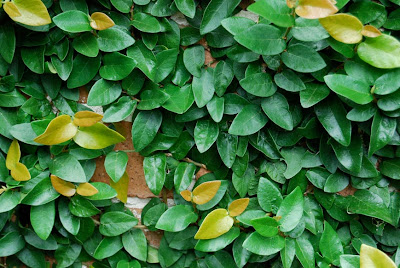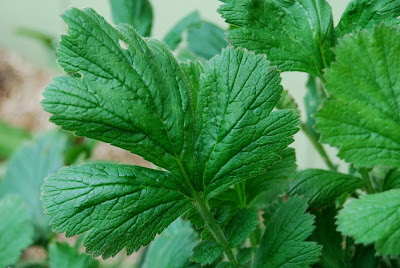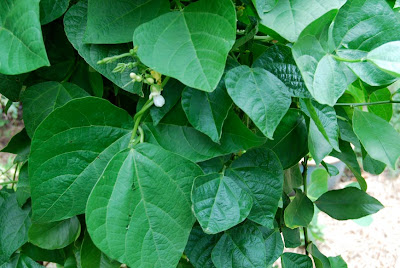Creating a potager garden (ie, a cutesy mix of flowers and food plants) is rather like conducting an orchestra – only in my case it has turned out to be a rather wilful, maverick orchestra of flowers and vegies. "Not yet, woodwinds" I can hear myself bellowing as they chime in several bars earlier than they should. "And timpani, what do you think you're doing – you're mean to wait until the violins have finished – what page are you on?" All my fault, really, trying to become an orchestral plant conductor when my gardening skills are the equivalent of not yet being able to read music. All that being said, here's the story of my little potager patch so far.
 Traaa daaaaa! This morning, December 31 (Happy New Year, Blogosphere!). Click on the photo to see it in more detail. Conical lettuce? Well, they do actually look quite interesting when they go to seed. And when you see their little flowers you discover that they really are members of the daisy family. But the idea was that the lettuce would be low and lush green companions to the baby marigolds. Hasn't quite turned out that way, but it's kind of pretty. But let's go back to the beginning, late October, and the potager patch was just a clapped out poppy patch ready for the garden cleaners to come in...
Traaa daaaaa! This morning, December 31 (Happy New Year, Blogosphere!). Click on the photo to see it in more detail. Conical lettuce? Well, they do actually look quite interesting when they go to seed. And when you see their little flowers you discover that they really are members of the daisy family. But the idea was that the lettuce would be low and lush green companions to the baby marigolds. Hasn't quite turned out that way, but it's kind of pretty. But let's go back to the beginning, late October, and the potager patch was just a clapped out poppy patch ready for the garden cleaners to come in... Late October – some lettuce and other salad greens in the foreground, with messy, rangey potato plants poking their head in on the right hand side, and a poor little curly parsley border struggling for land rights down the front. The poppies are exhausted, but having flowered well since June they've covered themselves in glory and will be back for a repeat performance next year.
Late October – some lettuce and other salad greens in the foreground, with messy, rangey potato plants poking their head in on the right hand side, and a poor little curly parsley border struggling for land rights down the front. The poppies are exhausted, but having flowered well since June they've covered themselves in glory and will be back for a repeat performance next year. After a thorough cleaning out, all that remained was the parsley border and a couple of baby silver beets. A potager seemed like a good, short-term plan for this spot, as it will have to make way for the poppies some time in late autumn.
After a thorough cleaning out, all that remained was the parsley border and a couple of baby silver beets. A potager seemed like a good, short-term plan for this spot, as it will have to make way for the poppies some time in late autumn. Before I started planting, I checked the soil pH and it was around 5.5, which is fairly acid, but nothing unusual for here. However, another dose of dolomite lime was applied, dug in and watered in, to gently raise it towards 6. Hopefully in another year or two it will eventually settle down around 6.5, which is about ideal for my needs.
Before I started planting, I checked the soil pH and it was around 5.5, which is fairly acid, but nothing unusual for here. However, another dose of dolomite lime was applied, dug in and watered in, to gently raise it towards 6. Hopefully in another year or two it will eventually settle down around 6.5, which is about ideal for my needs. Next, a layer of sugar cane mulch about one and a half inches thick (ie, 40mm). I used to mulch more thickly, but I have read several times lately in gardening magazines that new research shows that very thick mulches can actually repel rain and prevent soil from benefiting from all those medium to light showers that fall. So, 35-40mm is now the recommended depth for mulch here. They also say that coarse mulches are better than fine. Sugar cane mulch ticks all the boxes, and it's moderately priced without being truly cheap.
Next, a layer of sugar cane mulch about one and a half inches thick (ie, 40mm). I used to mulch more thickly, but I have read several times lately in gardening magazines that new research shows that very thick mulches can actually repel rain and prevent soil from benefiting from all those medium to light showers that fall. So, 35-40mm is now the recommended depth for mulch here. They also say that coarse mulches are better than fine. Sugar cane mulch ticks all the boxes, and it's moderately priced without being truly cheap. The black line on the right of the mulch is where one whole packet of curly parsley seed has gone, to extend the curly parsley border all the way round. I find parsley grows better from seed than seedlings (but it is slow to germinate, taking about 2-3 weeks usually). (Pictured top right is Mitchell, the garden's Librarian gnome, by the way).
The black line on the right of the mulch is where one whole packet of curly parsley seed has gone, to extend the curly parsley border all the way round. I find parsley grows better from seed than seedlings (but it is slow to germinate, taking about 2-3 weeks usually). (Pictured top right is Mitchell, the garden's Librarian gnome, by the way). Here's a selection of what went into the potager patch. Multi-coloured silver beet seed, curly parsley seed, lettuce seed and seedlings, shallots and carrot seedlings, dwarf marigold seedlings (mixed yellow and oranges), white vinca seedlings, ornamental kale seedlings (biggest mistake!), and two ornamental, colourful Thai chilli seedlings.
Here's a selection of what went into the potager patch. Multi-coloured silver beet seed, curly parsley seed, lettuce seed and seedlings, shallots and carrot seedlings, dwarf marigold seedlings (mixed yellow and oranges), white vinca seedlings, ornamental kale seedlings (biggest mistake!), and two ornamental, colourful Thai chilli seedlings. Over the next few weeks I fed the plants with Seasol and Nitrosol (mixed up 50:50 in a watering can). Seasol isn't a fertiliser, it's a soil conditioner which encourages roots to grow and generally helps plants establish faster. Nitrosol is labelled as 'liquid blood & bone' and it's a nitrogen-rich plant food. My other main duty during this time was to pick off all the flower buds from the marigolds, to encourage the plants to just grow. About two weeks ago, I switched over to feeding the marigolds with a 'flower and fruit' type of fertiliser, and let the forming flower buds get down to flowering.
Over the next few weeks I fed the plants with Seasol and Nitrosol (mixed up 50:50 in a watering can). Seasol isn't a fertiliser, it's a soil conditioner which encourages roots to grow and generally helps plants establish faster. Nitrosol is labelled as 'liquid blood & bone' and it's a nitrogen-rich plant food. My other main duty during this time was to pick off all the flower buds from the marigolds, to encourage the plants to just grow. About two weeks ago, I switched over to feeding the marigolds with a 'flower and fruit' type of fertiliser, and let the forming flower buds get down to flowering. And to repeat the first pic from this blog, here's the story this morning. On the far right of the patch the parsley border is just taking shape. It should really get going over the next few weeks. It's a bit lopsided looking, with holes here and there where the vincas haven't grown much yet.
And to repeat the first pic from this blog, here's the story this morning. On the far right of the patch the parsley border is just taking shape. It should really get going over the next few weeks. It's a bit lopsided looking, with holes here and there where the vincas haven't grown much yet. Here's a slightly closer look at the potager this morning. It's nice and colourful and the plants are healthy, so I can't really complain. The chillies are the strange looking things with the yellow, pointy but bulbous fruits, centre-left of the shot. They'll eventually turn a mixture of colours – yellow, purple, red and black, I hope. A few problems, all minor, are worth noting.
Here's a slightly closer look at the potager this morning. It's nice and colourful and the plants are healthy, so I can't really complain. The chillies are the strange looking things with the yellow, pointy but bulbous fruits, centre-left of the shot. They'll eventually turn a mixture of colours – yellow, purple, red and black, I hope. A few problems, all minor, are worth noting. 1. Some of the lettuce has gone to seed already, and so could have been planted at least two to three weeks after the flower seedlings, so they all chimed in together. However, new lettuce seedlings added this morning should be looking good in a few weeks, and hopefully the marigolds and vincas will still be looking nice, and the ornamental chillies will have grown and coloured up a bit more.
2. The vinca seedlings are way, way behind the marigolds, so next time I'd just stick to one type of flower, rather than trying to get two types to coordinate their flowering, always a difficult task. (Blame it on my liking for white flowers, and the fact the vincas should be about the same height as the marigolds). Hopefully they'll catch up some time in January.
3. The ornamental kale (at the back) is of course a winter crop. I just found some seedlings for sale in a local nursery, foolishly asked the person there whether they'd cope with the heat, and took their word for it that they'd be OK, as they do look great. These plants of course have bolted faster than a startled racehorse. They'll be replaced by colourful silver beet, which is what I should have planted there in the first place.
So, as for the lessons from my first attempt at a potager patch, there are just a few. The main one is to keep it simple, which I didn't really do. The other is to let the flower seedlings get at least three or four weeks head start before planting fast-growing vegies like lettuce and silver beet. Slower-growing vegies like the carrots and shallots are OK to plant at the same time as the flower seedlings.
I expect that by the end of January or early February the little potager patch should be in its prime – but that all depends on how hot, humid and harrowing this summer will be. If we get lucky and have just an average, slightly wet and humid summer, I might have a few more photos to add. Time will tell, but it has been fun so far, nevertheless!
































































